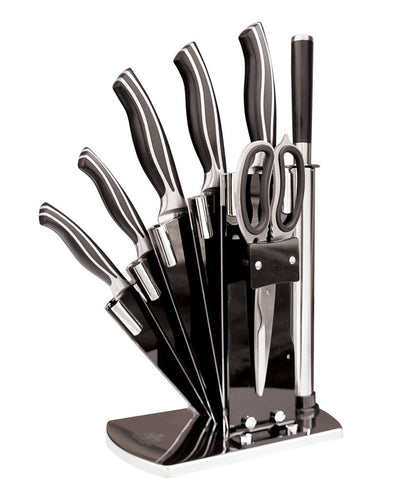A good knife is essential - especially if you are a serious chef or someone who takes cooking seriously. Some might not see the importance of a great knife and they think that battered and bent piece of stainless steel in their drawer is sufficient. We'll we are here to tell you that it's not! You might think your knife is a good knife but we know better. And like Crocodile Dundee, we will show what is and isn't a knife! If your knife crushes bread and rips meats, you must, toss it out. It's time to invest in a great knife and as a chef’s most utilized and important tool, a knife is something to be revered.
You might be thinking that any knife is fine. Maybe that knife that you found online and is endorsed by a celebrity chef is enough. Something you found at Walmart and splurged on for $17 after watching Iron Chef? Well again, sorry to tell you, but that knife is not good. Why are we so sure? Because knives are one area where quality truly does matter. We will break it down for you, what you want in a knife, and tell you the type of knives you need, tell you which knives you should own, and tell you how to take care of your new purchase.
The very first thing to look for when purchasing a knife is the quality of the steel. Regular steel is called carbon steel. It’s not great for your kitchen because it can rust. The next step up is common to most kitchens – stainless steel. The best knife for your kitchen is going to be a high carbon no-stain knife. Carbon in the blade is what gives it strength – too much carbon and your knife will break and rust. Not enough and it will be flexible and fail to hold an edge. No-stain or stain resistant is simply another way of saying “stainless steel” which refers to rust resistance and discoloration. However, even stain resistant things will rust, if not properly taken care of.
Was the knife stamped or forged? A stamped knife is one that is cut via a template out of a piece of steel. Think cookie cutter, basic factory stuff. It’s generally less dense than a forged knife which is created through a process of repeated heating, folding, and cooling. These knives tend to be denser, have better balance, and better edge retention.
Oh snap! It's about the tang. If you select a high carbon, stainless steel, forged blade, you will be getting a quality knife. Almost all knives that meet this criteria will also meet the third: full tang. Not Tang as in tangy - the tang of the knife is the steel that extends behind the blade. In a kitchen knife, often you’ll see the handle sometimes made from wood in older knives molded around the tang in a way that you can see the steel stretch in one uninterrupted piece from the tip to the end of the handle. This lends strength to the blade and prevents it from breaking. If a knife doesn’t have a full tang, the connection between the blade and the handle is much less sturdy, which can be dangerous at the worst and lead to a useless knife at best, if and once it does snap.
Safety first. A sharp blade is a safe blade. Once a blade begins to dull and you begin to actively force the knife to slice, rather than letting it slice, you increase the chance that you’ll force the blade somewhere it shouldn’t be. So a great blade therefore becomes a safety concern.
Getting a handle on the situation: We are specifically talking about the handle. A good handle should fit your hand well and offer a sure grip even when wet. A blade should have a finger guard right at the bolster (the area of the knife where the blade meets the handle). A finger guard is a specifically made piece or area that protects your finger from slipping. A finger guard is not included on all knives, which isn’t always a problem. A large blade, like a chef’s knife, generally wont have the blade come directly into the bolster, there will be a flat area that can’t cut you. Smaller knives, like slicers, maybe have a relatively sharp area, which could cut your finger.
The deluxe set comes with everything you could possibly need in a well-equipped kitchen! The basic starter group is a Chef's knife, paring knife and bread knife. We recommend investing in a quality knife set. There is a built in discount when you buy a set and you really get your money’s worth. For around $175 you get so much, our Triumph Hill 9 Pc Deluxe Cutlery Knife Set With Knife Stand & Magnetic Bar features a solid and steady construction, for long term durability, with everything you need for your kitchen.
The Set includes:
- 8" Chef Knife
- 8" Slicer
- 8" Bread Knife
- 5" Utility Knife
- 3.5" Fruit Knife
- Kitchen Scissors
- 8" Sharpener
- Acrylic Knife Stand
- 13" Magnetic Bar
The knives effortlessly glide through whatever they touch. They feel fantastic in the hand. The balance is great and they clean easily. They also look real "sharp!" Pun intended.
If you want to maximize your money and make a smart investment in a set of knives that will last you years, think about investing a quality set from DSD brands. You’ll be glad you did.
And if you’re going to invest in a good knife set, take care of it well.
The basics of knife care:
Use a Wooden Cutting Board. cutting boards, made of glass, or using plates etc..damage the fine edge of the blade. Wash by Hand. Even if your knife says it’s dishwasher safe, clean it by hand. This is better for the blade. Have them professionally sharpened when they dull. You can get your entire set sharpened back to new for about $25.


